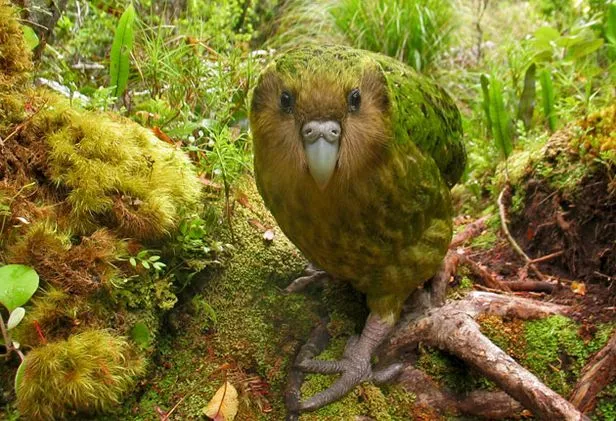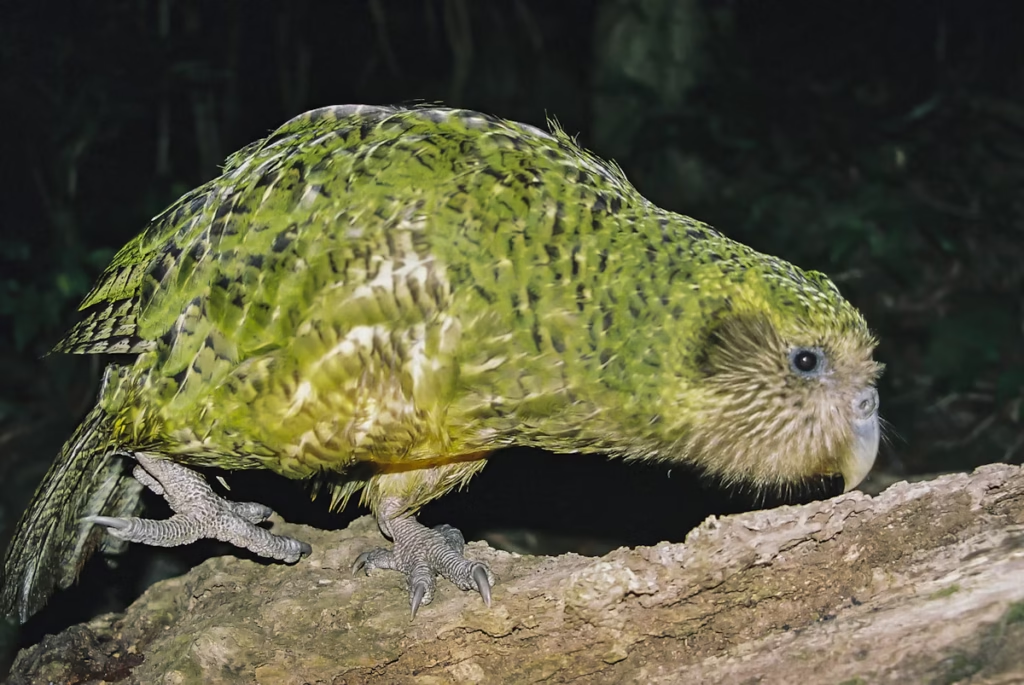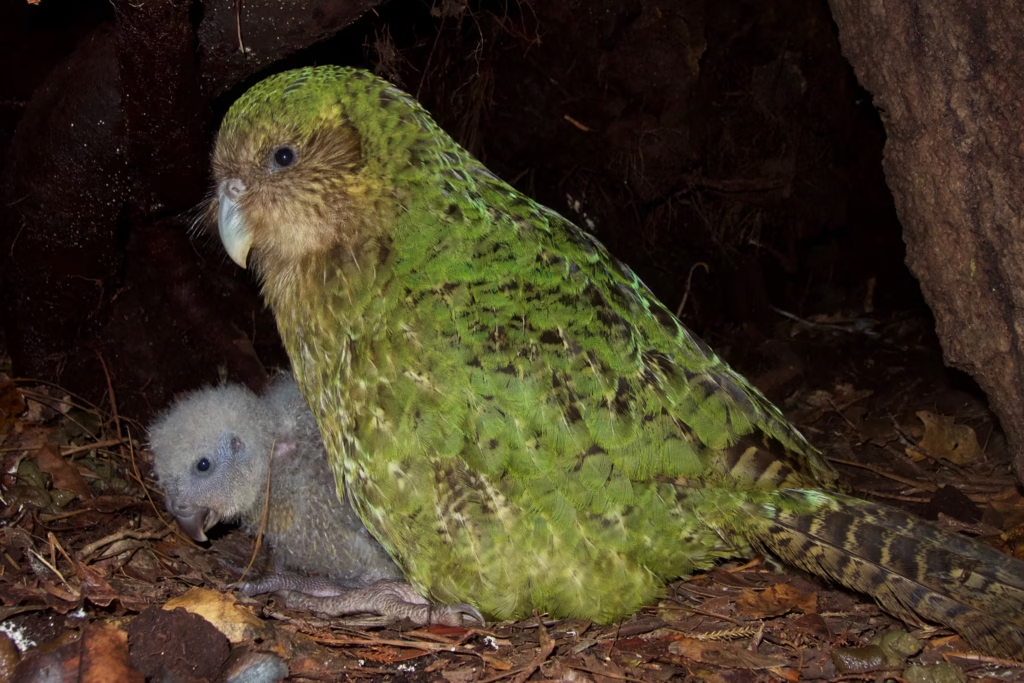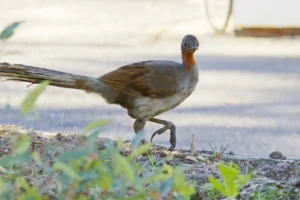Kakapo: The Night Parrot of New Zealand
Introduction
Deep in the misty forests of New Zealand lives one of the most extraordinary creatures on Earth—the kakapo (Strigops habroptilus). Sometimes called the “owl parrot” because of its nocturnal habits and facial disc of feathers, the kakapo is unlike any other parrot in the world. It is a giant, flightless, nocturnal, long-lived parrot that once thrived across New Zealand but now clings to survival with the help of one of the most intensive conservation programs ever attempted.
The kakapo is at once comical and majestic. With its moss-green plumage, large eyes, whisker-like feathers, and endearing waddling gait, it seems almost like a creature out of fantasy. Early European settlers described it as a “strange ground-dwelling bird that behaves like a dog, a rabbit, and a parrot combined.” Yet despite its unusual adaptations, the kakapo is critically endangered, with just over 250 individuals alive today—all named, tracked, and cared for by conservationists.
In this article, we’ll dive deep into the biology, history, behavior, threats, and conservation triumphs of this unique parrot.
Origins and Evolution
The kakapo belongs to the family Strigopidae, a lineage of parrots found only in New Zealand. Its closest relatives are the kea (a mischievous alpine parrot) and the kaka (a forest parrot).
An Island Evolutionary Story
New Zealand, separated from other landmasses for millions of years, evolved ecosystems without land mammals (apart from bats). In this environment, birds adapted to fill niches that mammals usually occupy elsewhere. The kakapo evolved to be:
- Flightless (no predators meant wings weren’t needed for escape).
- Ground-dwelling (took advantage of forest floors rich in roots, seeds, and fruit).
- Large and heavy (up to 4 kg, the heaviest parrot in the world).
- Nocturnal (avoided diurnal competition).
The absence of predators allowed the kakapo to thrive for thousands of years. But this specialization became a curse when humans—and their introduced animals—arrived.

Physical Characteristics
Size and Appearance
- Weight: 2–4 kg (males heavier than females).
- Length: 58–64 cm (23–25 inches).
- Wings: Short, rounded, used only for balance and parachuting down trees.
- Plumage: Moss-green with mottled black and yellow, providing excellent camouflage in ferns and moss.
- Face: Soft, whisker-like feathers and a rounded disc that gives an owl-like look.
- Beak: Strong, adapted for chewing fibrous plants.
- Feet: Large, scaly, and powerful for climbing.
Unique Traits
- Flightlessness: Their breastbone lacks the keel where flight muscles attach.
- Nocturnal habits: Excellent sense of smell (rare in birds) helps locate food at night.
- Longevity: Can live 60–90 years, among the longest-lived birds.
- Scent: Kakapos emit a musky, sweet odor detectable by predators—one of their evolutionary flaws.
Behavior and Ecology
Daily Life
Kakapos spend nights foraging for plants, fruits, seeds, and roots. By day, they rest in tree cavities or under vegetation. They are solitary and occupy defined home ranges, marked by scent trails.
Diet
- Native fruits (especially the rimu tree fruit, critical for breeding).
- Roots, leaves, and seeds.
- Mosses and ferns.
They use their beak to grind fibrous food into pulp, discarding indigestible parts in small clumps called “chews.”

Reproduction
The kakapo has one of the most unusual breeding systems among birds:
- Lek breeding: Males gather at display arenas, where each digs a shallow bowl in the ground.
- Booming calls: Males inflate their chest sacs and produce deep “booms” that travel up to 5 km through valleys. After weeks of booming, they switch to metallic “chings.”
- Female choice: Females visit males and choose a mate based on his display.
- Breeding linked to fruit: They breed only in years when rimu and other trees mast (produce large fruit crops), often every 2–4 years.
- Clutch size: 1–4 eggs, incubated only by the female.
This irregular, low reproductive rate is a major reason for the species’ vulnerability.
Cultural Significance
For the Māori people, the kakapo was woven into cultural life.
- Feathers: Used to make cloaks (kahu kakapo), prized for softness and warmth.
- Food source: Hunted for meat.
- Pet status: Kakapos were sometimes kept as affectionate companions, described as playful and gentle.
Māori respected the bird but also contributed to early population declines through hunting.
Decline After Human Arrival
Arrival of Māori (13th century)
- Hunting for food and feathers.
- Habitat destruction through burning forests.
- Rats (kiore) preyed on eggs and chicks.
Arrival of Europeans (18th–19th centuries)
- New predators introduced: cats, stoats, ferrets, dogs.
- Kakapos, being flightless and musky-smelling, were easy prey.
- By the late 1800s, kakapos were already scarce.
Near Extinction (20th century)
By the 1970s, the species was thought to be functionally extinct. Only a few scattered individuals remained in remote Fiordland.
Conservation: A Legendary Effort
The kakapo’s survival today is thanks to one of the most ambitious conservation programs in the world.
Rediscovery
- 1974: A male kakapo named Richard Henry was captured in Fiordland, proving the species still survived.
- 1977–1990s: More individuals were discovered on Stewart Island, but cats devastated the population.
The Kakapo Recovery Program
In 1995, the New Zealand Department of Conservation launched the Kakapo Recovery Program, supported by international partners.
Key strategies:
- Translocation: All kakapos were moved to predator-free offshore islands (Codfish, Little Barrier, Anchor Islands).
- Intensive management: Every bird is named, tagged, and monitored with radio transmitters.
- Supplementary feeding: Females are provided high-calorie food to improve breeding success.
- Artificial insemination: Used to maximize genetic diversity.
- Hand-rearing chicks: Eggs and chicks are carefully incubated and raised if mothers fail.
- Genomic studies: Full genome sequencing aids in managing inbreeding.
Population Recovery
- 1995: Only 50 birds left.
- 2020s: Over 250 individuals.
Every kakapo alive today has a name and history—celebrities like Sirocco (the “spokesbird” famous for attempting to mate with a zoologist’s head on BBC).
Challenges Ahead
Despite successes, kakapos remain critically endangered.
Problems
- Genetic bottleneck: With so few founders, inbreeding depression is a risk.
- Climate change: Alters masting cycles of rimu trees, disrupting breeding.
- Disease: Vulnerable to avian diseases (aspergillosis outbreak in 2019 killed several birds).
- Slow reproduction: Irregular breeding and low fertility rates mean recovery is fragile.
Conservationists must continue intensive management indefinitely for the species’ survival.
Kakapo in Popular Culture
- Featured in Douglas Adams’ book “Last Chance to See”, which brought global attention.
- Became an internet sensation after “Sirocco the Kakapo” video went viral on YouTube.
- National symbol of hope in New Zealand conservation efforts.
The kakapo has gone from near-extinction to becoming a global conservation icon, showing what dedicated human effort can achieve.
Fascinating Facts
- Heaviest parrot: Up to 4 kg.
- Nocturnal parrot: One of the only nocturnal parrots in the world.
- Strong scent: Unlike most birds, has a noticeable musky aroma.
- Long lifespan: May live up to 90 years.
- Every bird has a name: From Kuia to Sirocco, each kakapo is an individual.
- Climbing skills: Though flightless, kakapos climb trees with their strong legs and glide down.
Table: Kakapo at a Glance
| Feature | Description |
|---|---|
| Scientific Name | Strigops habroptilus |
| Family | Strigopidae |
| Weight | 2–4 kg |
| Length | 58–64 cm |
| Range | New Zealand (offshore islands only) |
| Habitat | Native podocarp forests |
| Breeding System | Lek; booming and chinging |
| Clutch Size | 1–4 eggs |
| Conservation Status | Critically Endangered (IUCN) |
| Current Population | ~250 individuals (2025) |
| Unique Feature | Flightless, nocturnal, musky scent |
| Lifespan | 60–90 years |
Final Thoughts
The kakapo is a living paradox: a giant parrot that cannot fly, a bird that smells strongly in a world where scent invites danger, a species that breeds only when trees fruit irregularly. By all odds, it should not have survived into the modern age. And yet, against all odds, it has.

Its story is not just about a bird—it is about humanity’s ability to reverse the damage it has done. Once written off as doomed, the kakapo is now recovering through dedication, science, and love. It stands as proof that extinction is not inevitable if we care enough to act.
The kakapo’s booming calls still echo through New Zealand’s forests, a deep reminder of resilience. Whether the species will fully recover remains uncertain, but one thing is clear: the kakapo is no longer just New Zealand’s bird—it is the world’s bird, a symbol of hope for conservation everywhere.

